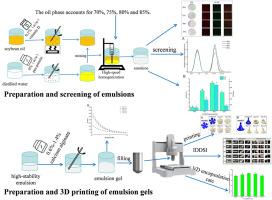Development of 3D-printed pea protein-based vitamin D3 carrier emulsion gel system with high stability and its optimization
IF 11
1区 农林科学
Q1 CHEMISTRY, APPLIED
引用次数: 0
Abstract
This paper developed a novel pea protein (PP)-based emulsion gel system exhibiting high stability and tailored 3D printability for efficient vitamin D3 delivery to dysphagia patients. A soybean oil-in-water emulsion, stabilized by PP and loaded with vitamin D3, was first optimized. Systematic evaluation, including particle size analysis, emulsifying properties, and confocal laser scanning microscopy (CLSM), identified an 80 % oil phase ratio as optimal. This formulation achieved a creaming index of 0 %, a minimal volume-weighted mean diameter (D[4,3]) of 19.55 μm, a homogeneous microstructure, an emulsifying activity index of 6.95 m2/g, and an emulsifying stability index of 445.25 min. Subsequent incorporation of 1.0 % calcium alginate (CA) endowed the emulsion with ideal shear-thinning behavior and mechanical strength for 3D printing, resulting in high printing precision (88.34 %) and excellent shape retention. The 3D-printed gel maintained a high vitamin D3 retention rate of 86.35 % and exhibited texture properties (hardness: 191.56 g; chewiness: 13.15 N s) compliant with International Dysphagia Diet Standardisation Initiative (IDDSI) Level 4–5 standards, ensuring swallowing safety. Mechanistic analysis indicated that ionic cross-linking between PP and CA formed a stable three-dimensional network, which effectively protected vitamin D3 and inhibited droplet coalescence. This work provides a viable strategy for creating plant protein-based delivery systems aimed at personalized nutrition for dysphagia management.

3d打印豌豆蛋白基高稳定性维生素D3载体乳液凝胶体系的研制及优化
本文开发了一种新型的豌豆蛋白(PP)乳液凝胶体系,具有高稳定性和量身定制的3D打印能力,可有效地为吞咽困难患者提供维生素D3。首先对大豆油水乳状液进行了优化,并以聚丙烯为稳定剂,添加了维生素D3。系统评估,包括粒度分析、乳化性能和共聚焦激光扫描显微镜(CLSM),确定80%的油相比为最佳。该配方的乳化指数为0%,最小体积加权平均直径(D[4,3])为19.55 μm,微观结构均匀,乳化活性指数为6.95 m2/g,乳化稳定性指数为445.25 min。随后加入1.0%海藻酸钙(CA),使乳液具有理想的剪切减薄性能和3D打印的机械强度,从而获得高打印精度(88.34%)和优异的形状保持性。3d打印凝胶保持了86.35%的维生素D3保留率,其质地性能(硬度:191.56 g,嚼劲:13.15 N s)符合国际吞咽困难饮食标准化组织(IDDSI) 4-5级标准,确保吞咽安全。机理分析表明,PP和CA之间的离子交联形成了稳定的三维网络,有效地保护了维生素D3,抑制了液滴的聚结。这项工作为创建基于植物蛋白的输送系统提供了一种可行的策略,旨在为吞咽困难的管理提供个性化的营养。
本文章由计算机程序翻译,如有差异,请以英文原文为准。
求助全文
约1分钟内获得全文
求助全文
来源期刊

Food Hydrocolloids
工程技术-食品科技
CiteScore
19.90
自引率
14.00%
发文量
871
审稿时长
37 days
期刊介绍:
Food Hydrocolloids publishes original and innovative research focused on the characterization, functional properties, and applications of hydrocolloid materials used in food products. These hydrocolloids, defined as polysaccharides and proteins of commercial importance, are added to control aspects such as texture, stability, rheology, and sensory properties. The research's primary emphasis should be on the hydrocolloids themselves, with thorough descriptions of their source, nature, and physicochemical characteristics. Manuscripts are expected to clearly outline specific aims and objectives, include a fundamental discussion of research findings at the molecular level, and address the significance of the results. Studies on hydrocolloids in complex formulations should concentrate on their overall properties and mechanisms of action, while simple formulation development studies may not be considered for publication.
The main areas of interest are:
-Chemical and physicochemical characterisation
Thermal properties including glass transitions and conformational changes-
Rheological properties including viscosity, viscoelastic properties and gelation behaviour-
The influence on organoleptic properties-
Interfacial properties including stabilisation of dispersions, emulsions and foams-
Film forming properties with application to edible films and active packaging-
Encapsulation and controlled release of active compounds-
The influence on health including their role as dietary fibre-
Manipulation of hydrocolloid structure and functionality through chemical, biochemical and physical processes-
New hydrocolloids and hydrocolloid sources of commercial potential.
The Journal also publishes Review articles that provide an overview of the latest developments in topics of specific interest to researchers in this field of activity.
 求助内容:
求助内容: 应助结果提醒方式:
应助结果提醒方式:


